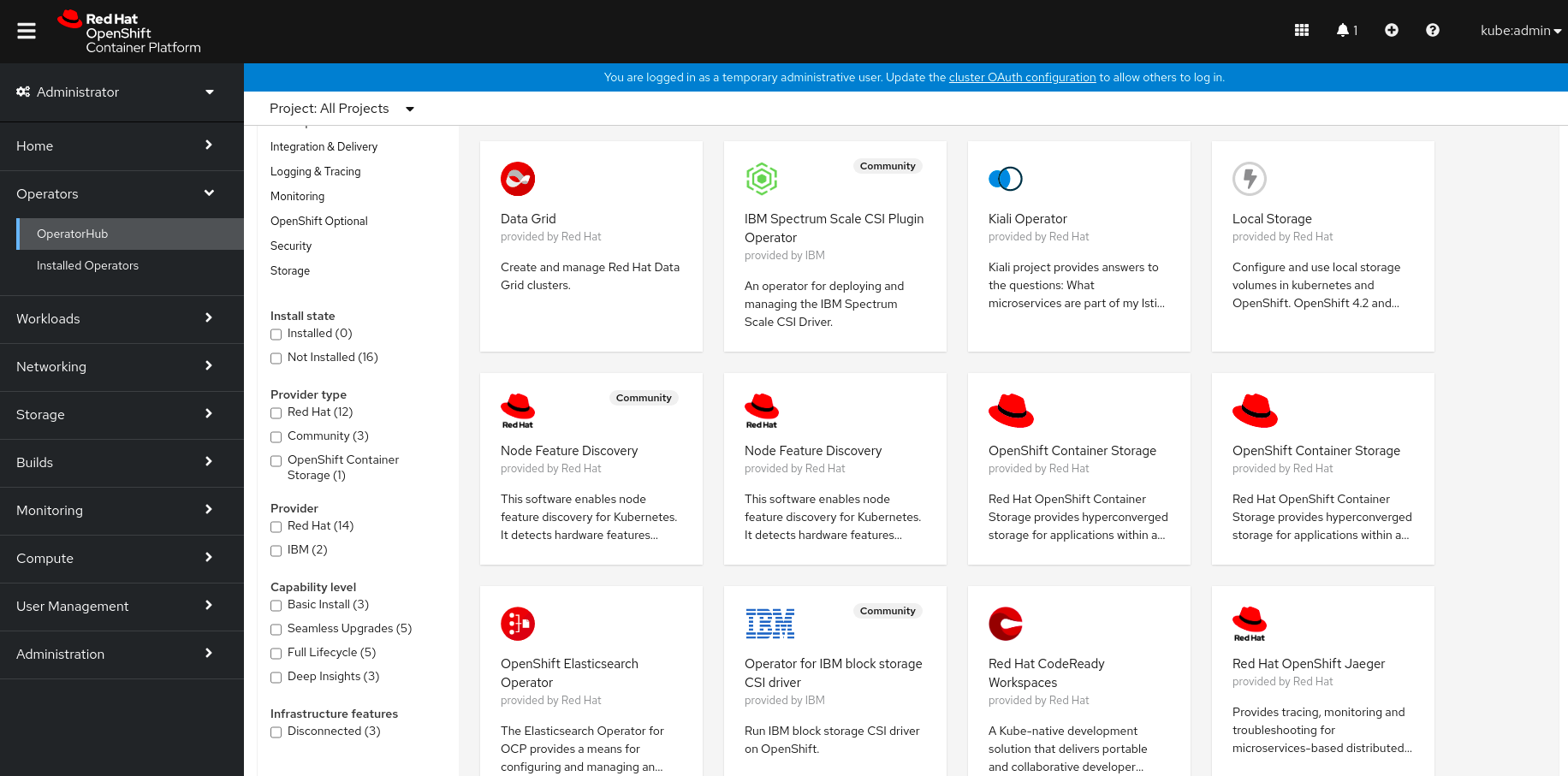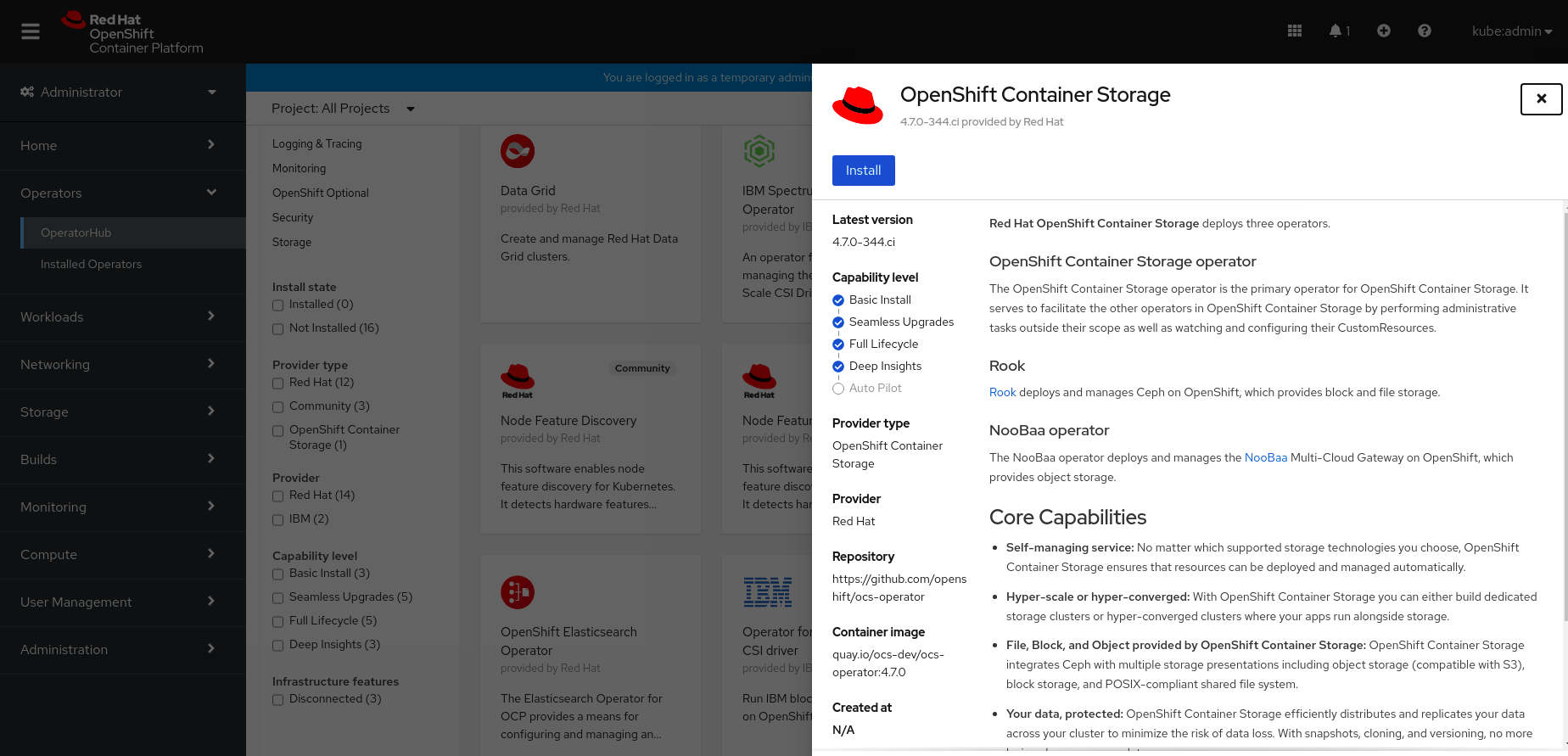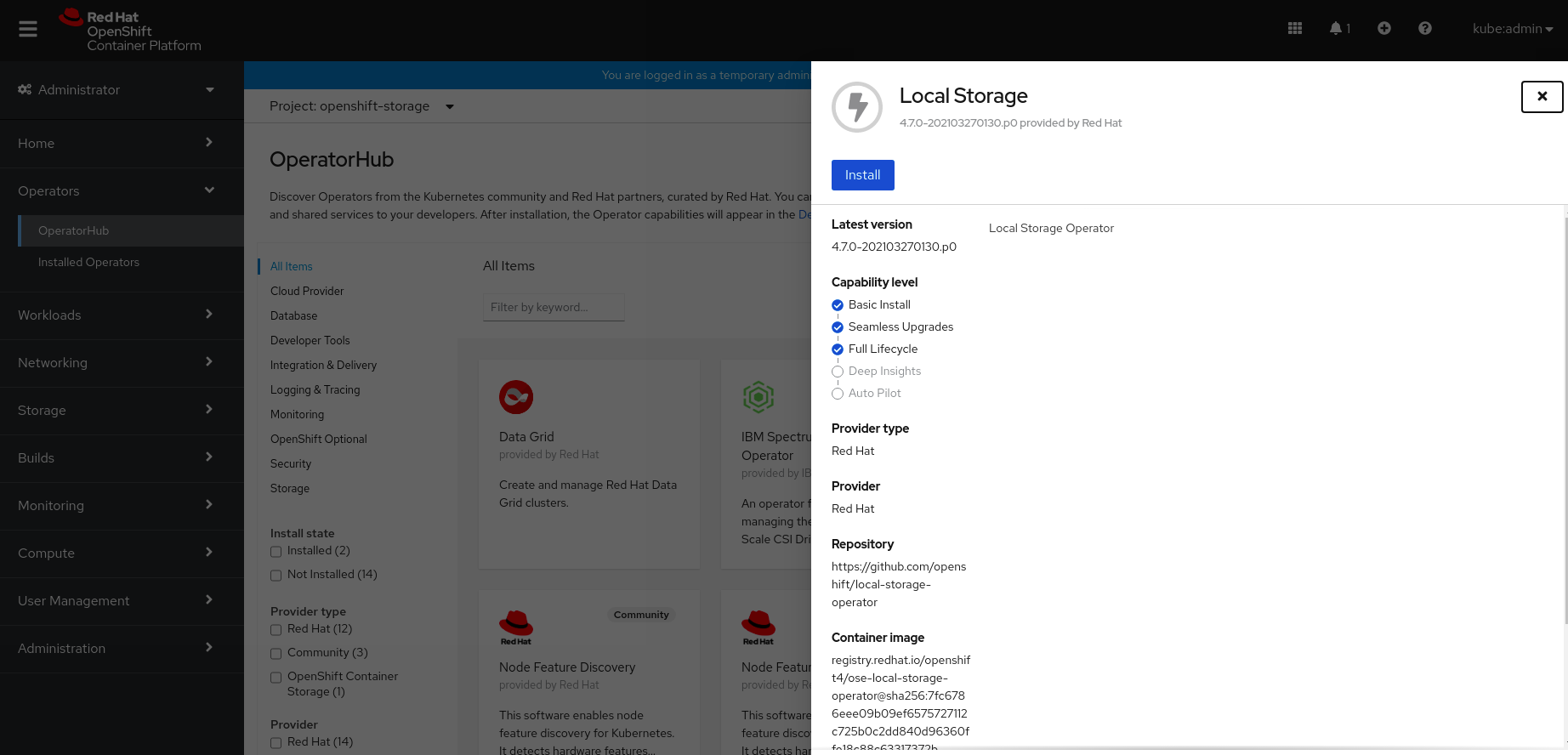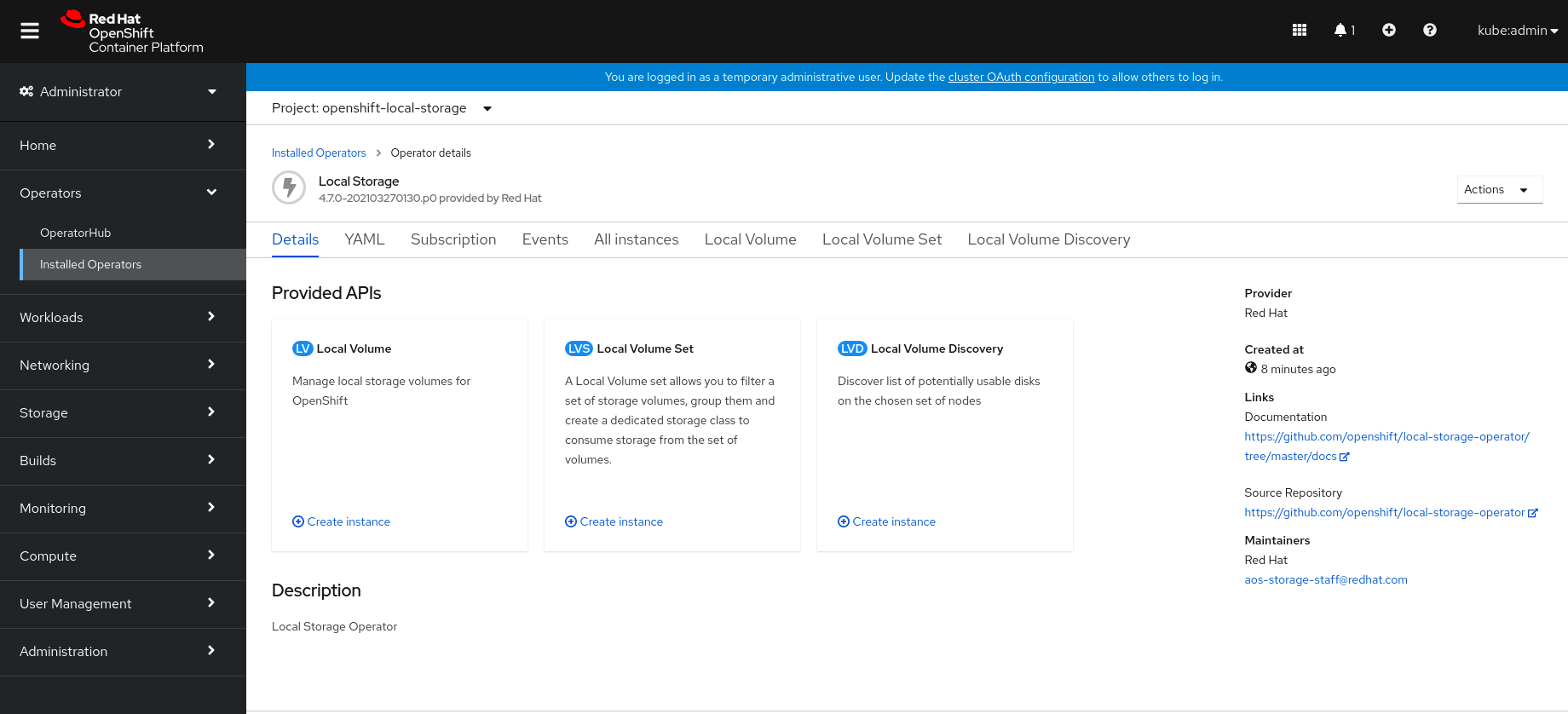Chapter 1. Deploying using local storage devices
Deploying OpenShift Container Storage on OpenShift Container Platform using local storage devices provided by IBM Power Systems enables you to create internal cluster resources. This approach internally provisions base services. Then, all applications can access additional storage classes.
Only internal Openshift Container Storage clusters are supported on IBM Power Systems. See Planning your deployment for more information about deployment requirements.
1.1. Requirements for installing OpenShift Container Storage using local storage devices
The cluster must consist of at least three OpenShift Container Platform worker nodes in the cluster with locally attached storage devices on each of them.
- Each of the three selected nodes must have at least one raw block device available to be used by OpenShift Container Storage.
- The devices to be used must be empty, that is, there should be no persistent volumes (PVs), volume groups (VGs), or local volumes (LVs) remaining on the disks.
You must have a minimum of three labeled nodes.
Each node that has local storage devices to be used by OpenShift Container Storage must have a specific label to deploy OpenShift Container Storage pods. To label the nodes, use the following command:
$ oc label nodes <NodeNames> cluster.ocs.openshift.io/openshift-storage=''
Minimum starting node requirements
See Resource requirements section in Planning guide.
Requirements for upgrading local storage devices
- You must upgrade to the OpenShift Container Platform 4.7 before deploying OpenShift Container Storage 4.7. For information, see Updating OpenShift Container Platform clusters guide.
- The Local Storage Operator version must match the Red Hat OpenShift Container Platform version in order to have the Local Storage Operator fully supported with Red Hat OpenShift Container Storage. Upgrading Red Hat OpenShift Container Platform does not upgrade the Local Storage Operator.
1.2. Installing Red Hat OpenShift Container Storage Operator
You can install Red Hat OpenShift Container Storage Operator using the Red Hat OpenShift Container Platform Operator Hub. For information about the hardware and software requirements, see Planning your deployment.
Prerequisites
- Access to an OpenShift Container Platform cluster using an account with cluster-admin and Operator installation permissions.
- You must have at least three worker nodes in the RHOCP cluster.
When you need to override the cluster-wide default node selector for OpenShift Container Storage, you can use the following command in command line interface to specify a blank node selector for the openshift-storage namespace:
$ oc annotate namespace openshift-storage openshift.io/node-selector=
Procedure
Navigate in the left pane of the OpenShift Web Console to click Operators → OperatorHub .
Figure 1.1. List of operators in the Operator Hub

Click on OpenShift Container Storage.
You can use the Filter by keyword text box or the filter list to search for OpenShift Container Storage from the list of operators.
Click Install on the OpenShift Container Storage operator page.
Figure 1.2. Install Operator page

After Clicking on Install button, following page will appear.

On the Install Operator page, the following options are selected by default:
- Update Channel as stable-4.7
- Installation Mode as A specific namespace on the cluster
-
Installed Namespace as Operator recommended namespace openshift-storage. If Namespace
openshift-storagedoes not exist, it will be created during the operator installation. - Select Approval Strategy as Automatic or Manual.
Click Install.
If you selected Automatic updates, then the Operator Lifecycle Manager (OLM) automatically upgrades the running instance of your Operator without human intervention. If you selected Manual updates, then the OLM creates an update request. As a cluster administrator, you must then manually approve that update request to have the Operator updated to the new version.
Verification steps
- Verify that OpenShift Container Storage Operator shows a green tick indicating successful installation.
Click View Installed Operators in namespace openshift-storage link to verify that OpenShift Container Storage Operator shows the Status as
Succeededon the Installed Operators dashboard.Figure 1.3. Installed Operators dashboard

1.3. Installing Local Storage Operator
Use this procedure to install the Local Storage Operator from the Operator Hub before creating OpenShift Container Storage clusters on local storage devices.
Procedure
- Click Operators → OperatorHub in the left pane of the OpenShift Web Console.
- Search for Local Storage Operator from the list of operators and click on it.
Click Install.
Figure 1.4. Install Operator page

After Clicking on Install button, following page will appear.

Set the following options on the Install Operator page:
- Update Channel as stable-4.7
- Installation Mode as A specific namespace on the cluster
- Installed Namespace as Operator recommended namespace openshift-local-storage.
- Approval Strategy as Automatic
Click Install.
Figure 1.5. Installed Operators dashboard

Verification steps
-
Verify that the Local Storage Operator shows the Status as
Succeeded.
1.4. Creating OpenShift Container Storage cluster on IBM Power Systems
Prerequisites
- Ensure that all the requirements in the Requirements for installing OpenShift Container Storage using local storage devices section are met.
- You must have a minimum of three worker nodes with the same storage type and size attached to each node (for example, 200 GB SSD) to use local storage devices on IBM Power Systems.
Verify your OpenShift Container Platform worker nodes are labeled for OpenShift Container Storage:
oc get nodes -l cluster.ocs.openshift.io/openshift-storage -o jsonpath='{range .items[*]}{.metadata.name}{"\n"}'
Procedure
- Log into the OpenShift Web Console.
In
openshift-local-storagenamespace Click Operators → Installed Operators from the left pane of the OpenShift Web Console to view the installed operators.Figure 1.6. Local Storage Operator page

- Click the Local Storage installed operator.
On the Operator Details page, click the Local Volume Set link.
Figure 1.7. Local Volume Set tab

Click Create Local Volume Set.

- Enter the Volume Set name. By default, Storage Class name appears for the Volume Set name.
To discover available disks, you can choose one of the following:
- All nodes to discover disks in all the nodes.
Select nodes to choose a subset of nodes from a list of nodes
To find specific worker nodes in the cluster, you can filter nodes on the basis of Name or Label. Name allows you to search by name of the node and Label allows you to search by selecting the predefined label.
Select the Disk type. The following options are available:
All
Selects all types of disks present on the nodes. By default, this option is selected.
SSD/NVME
Selects only SSD NVME type of disks.
HDD
Selects only HDD type of disks.
In the Advanced section, you can set the following:
Volume Mode
Block is selected by default.
Disk Size
Minimum and maximum avaialable size of the device that needs to be included.
NoteChoose the minimum disk size equivalent to the size of additional attached disk.
Max Disk Limit
This indicates the maximum number of PVs that can be created on a node. If this field is left empty, then PVs are created for all the available disks on the matching nodes.
Click Create.
The Create button is enabled only after you select a minimum of three nodes. Local Volume Set is created with one volume per worker node with the available disks.
In
openshift-storagenamespace Click Operators → Installed Operators from the left pane of the OpenShift Web Console to view the installed operators.Figure 1.8. OpenShift Container Storage Operator page

- Click the OpenShift Container Storage installed operator.
On the Operator Details page, click the Storage Cluster link.
Figure 1.9. Storage Cluster tab

Click Create Storage Cluster.

Select Internal-Attached devices for the Select Mode.

- Select the required storage class.
- The nodes corresponding to the storage class are displayed based on the storage class that you selected from the drop down.
- Click Next.
Again Click Next and then you will be redirected to Review and Create page.
Review the configurations details. To modify any configuration settings, click Back to go back to the previous configuration page.

- Click Create.
Verification steps
See Verifying your OpenShift Container Storage installation.
Additional resources
To expand the capacity of the initial cluster, see the Scaling Storage guide.

